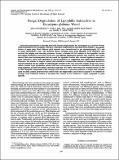Por favor, use este identificador para citar o enlazar a este item:
http://hdl.handle.net/10261/3568COMPARTIR / EXPORTAR:
 SHARE
BASE SHARE
BASE
|
|
| Visualizar otros formatos: MARC | Dublin Core | RDF | ORE | MODS | METS | DIDL | DATACITE | |

| Título: | Fungal degradation of lipophilic extractives in Eucalyptus globulus wood. |
Autor: | Gutiérrez Suárez, Ana CSIC ORCID ; Río Andrade, José Carlos del CSIC ORCID ; Martínez, María Jesús CSIC ORCID ; Martínez, Ángel T. CSIC ORCID | Fecha de publicación: | 1999 | Editor: | American Society for Microbiology | Citación: | Applied and Environmental Microbiology 65(4): 1367–1371 (1999) | Resumen: | Solid-state fermentation of eucalypt wood with several fungal strains was investigated as a possible biological pretreatment for decreasing the content of compounds responsible for pitch deposition during Cl2-free manufacture of paper pulp. First, different pitch deposits were characterized by gas chromatography (GC) and GC-mass spectrometry (MS). The chemical species identified arose from lipophilic wood extractives that survived the pulping and bleaching processes. Second, a detailed GC-MS analysis of the lipophilic fraction after fungal treatment of wood was carried out, and different degradation patterns were observed. The results showed that some basidiomycetes that decreased the lipophilic fraction also released significant amounts of polar extractives, which were identified by thermochemolysis as originating from lignin depolymerization. Therefore, the abilities of fungi to control pitch should be evaluated after analysis of compounds involved in deposit formation and not simply by estimating the decrease in the total extractive content. In this way, Phlebia radiata, Funalia trogii, Bjerkandera adusta, and Poria subvermispora strains were identified as the most promising organisms for pitch biocontrol, since they degraded 75 to 100% of both free and esterified sterols, as well as other lipophilic components of the eucalypt wood extractives. Ophiostoma piliferum, a fungus used commercially for pitch control, hydrolyzed the sterol esters and triglycerides, but it did not appear to be suitable for eucalypt wood treatment because it increased the content of free sitosterol, a major compound in pitch deposits. | Versión del editor: | http://aem.asm.org/cgi/content/abstract/65/4/1367 | URI: | http://hdl.handle.net/10261/3568 | ISSN: | 1098-5336 |
| Aparece en las colecciones: | (IRNAS) Artículos (CIB) Artículos |
Ficheros en este ítem:
| Fichero | Descripción | Tamaño | Formato | |
|---|---|---|---|---|
| 1999-GUTIERREZ-AEM.pdf | 85,65 kB | Adobe PDF |  Visualizar/Abrir |
CORE Recommender
Page view(s)
341
checked on 22-abr-2024
Download(s)
202
checked on 22-abr-2024
Google ScholarTM
Check
NOTA: Los ítems de Digital.CSIC están protegidos por copyright, con todos los derechos reservados, a menos que se indique lo contrario.
